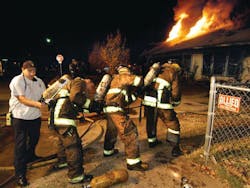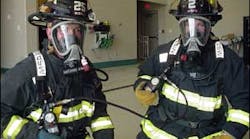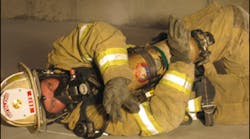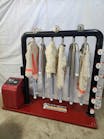NFPA 1981 2013 Edition: What Do You Need to Know?
Without a doubt, self-contained breathing apparatus (SCBA) is the most important and widely used tool in the fire service today. Its use has greatly expanded the capacities of firefighters when performing fire attack and searches or hazmat and technical rescue operations while successfully reducing the number of firefighter fatalities and injuries related to inadequate respiratory protection.
Equipment of such importance warrants close scrutiny. How much change is necessary and to what extent will it help us as a fire service must be asked. NFPA 1981 is the Standard for Open Circuit Self-Contained Breathing Apparatus for Fire and Emergency Services. This standard has undergone several changes with the 1997, 2002 and 2007 editions that have had a significant impact on SCBA used by the fire service.
Most notable changes in this time period in the 1997 and 2002 revisions were requirements for redundant low pressure warning devices, heads up display (HUD) or a visual signal signifying the amount of an air cylinder's rated capacity present and the RIC Universal Air Coupling (RIC UAC). In the 2007 revision, focus was turned to the perceived weakest link of the SCBA; electronics. Stricter testing methods were passed to improve the performance and sustainability of electronic components of the SCBA. All of these changes were undoubtedly very important safety improvements.
The publication of the 2013 edition of NFPA 1981 took place this week. This standard is expected to be in full effect by August, which in essence means that any units manufactured after August 2013 must meet the requirements of the new edition for NFPA certification. Many of the new changes are operational related.
It can be stated that the following three changes will take center stage with the new edition of the standard:
- testing for increased facepiece lens integrity
- new voice communication intelligibility requirements
- changes to the end of service time indicator
Testing for Increased Face Piece Lens Integrity
No specific test has ever been defined for just the SCBA facepiece lens. The 2013 edition will define specific durability requirements for facepieces. Several firefighter fatalities in the past few years have brought attention to the integrity of SCBA. lenses being compromised under hostile conditions. Changes in today's fireground environment have necessitated this change - higher BTU release and shorter flashover windows have an increased detrimental effect on the traditional polycarbonate SCBA lenses worn by firefighters. These changes have caused the different coatings of these lenses to expand and contract at different rates causing crazing and eventual failure as well as total failure because of the softness in the lens brought on by high heat.
In the 2007 edition of the standard, complete SCBA. ensembles are required to pass specific testing parameters. The only facepiece requirement in this test is to maintain visual acuity and positive pressure after a five minute oven test at 200 degrees and a 10 second direct flame impingement test.
The 2013 NFPA revision will call for specific tests for the facepiece itself. A high heat and flame test which will utilize convected heat to test the SCBA after a five minute oven test at 500 degrees and 10 second direct flame impingement test both while maintaining a flow rate of 40 liters per minute (LPM), which is the estimated average breathing rate, according to NIOSH. There will be no requirements for visual acuity, but the SCBA must maintain positive pressure for a time period of 24 minutes.
A second test for the facepiece using radiant heat will also be utilized. While flowing 40 LPM the facepiece will be exposed to radiant heat at rate of 15 Kilowatts per square meter for a five minute interval. Again, positive pressure must be maintained for a period of 24 minutes afterward.
New Voice Communication Intelligibility Requirements
The NFPA 2007 revision brought changes to testing requirements for voice intelligibility. This is again be approached in the 2013 revision. In the previous edition, testing is performed with five listeners recording words read by a speaker outfitted with the unit being tested. This is done with 70 decibels of background noise. A score higher than 85 was required for passing with distances between the speaker and listeners being 15 feet.
The 2013 revision will set requirements to remove subjectivity from the testing process. Specialized testing equipment will replace humans to simulate sounds and communications. These tests will also be performed for mechanical as well as amplified communication performance.
Changes To The End of Service Time Indicator
The most noticeable change with the revision of the NFPA 1981 standard will be seen with new requirements for the end of service time indicator. The requirement for the end of service time indicator has been 25% of the cylinder's rated capacity. The new requirement will mandate that the alarm now sound at the point when 33% of the cylinders rated capacity is reached.
This will be a difficult requirement for a lot of firefighters to accept because it is something new and different from what they have been accustomed to throughout their careers, but lets face it, 25 % warning is not adequate and it can even be debated that 33% is still not enough.
NFPA 1404 has stated for more than several years now that firefighters must drill on and practice sound air management techniques and that we should be outside of the hazard area when the end of service indicator activates. With the changes in today's fireground environment changes like this only make sense for the better which can be discussed in length way beyond the scope of this article.
Along the lines of this change, heads up display (HUD) indicators will now be required to display signals at 75%, 50% and 33% as opposed to just 50% in previous editions.
The one area in which some operational challenges can be encountered due to these changes though is the instances in which departments can not replace or retrofit all of their SCBA. units at one time and have units meeting the previous NFPA requirements commingled with new 2013 compliant units on their apparatus. Serious thought and consideration must be given to this area by departments if this situation can exist and a clear solution of how to deal with this must be understood by all department members using the equipment.
Not as prominent, but still important to mention is that minimum performance requirements will also now be listed for emergency breathing support systems (EBSS) in the 2013 edition. It has never been previously recognized or accepted by NIOSH.
Intrinsic safety requirements to meet Class 1, Division 1 as set forth in the 6th edition of UL 913 will also be called for. This requirement will also be present in the new edition of NFPA 1982 which covers PASS devices. As a side note, the 2013 edition of NFPA 1981 will call for a universal alarm for all PASS devices from the pre-alarm to the full alarm stage.
The best comment that I can end this article with is to make certain that firefighters on your department are trained to a level that will help them feel both comfortable and confident in the SCBA that they use. In addition, solid skills in risk/benefit analysis go a long way on the fireground. Standards and improvements definitely help us in making certain that our firefighters are given the proper equipment and tools to work safely, but without proper training they do not provide us with any advantage. Remember, standards have been written as a result of problems being identified that have caused us to have someone seriously hurt or killed in the performance of their duties. Keep your people informed and trained on the equipment that their lives depend on.
You can find NFPA 1981 at: www.nfpa.org/1981
JEFFREY PINDELSKI, a 24-year plus student of the fire service, is the deputy chief of operations with the Downers Grove, IL, Fire Department. He is a Firehouse.com contributing editor and is the co-author of the text: R.I.C.O.- Rapid Intervention Company Operations, and is a revising author of the third edition of the Firefighter's Handbook. Pindelski has earned a masters degree from Lewis University and was a recipient of the State of Illinois Firefighting Medal of Valor in 1998.








